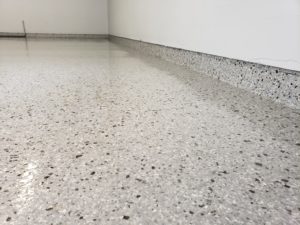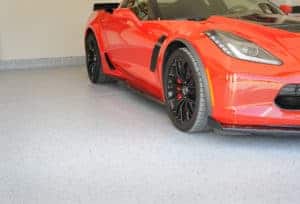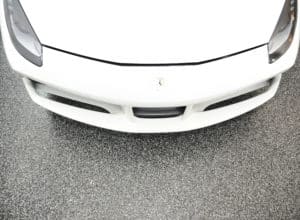You may have heard about epoxy floor coatings, 2-component coatings available at your local hardware store. If you didn’t know otherwise, you’d think this was the only type of coating available. In fact, there are several types, each with important advantages and disadvantages.
Choose the wrong product for your project and you’ll be re-coating within a year!
Different Coating Product Types
So what are the different types of coating products and what’s the difference? There are 3 main types:
- Epoxy
- Polyurethane
- Polyurea & Polyaspartic
(Before discussing the differences, know that for each coating type there are huge variations in product quality. Even if you select the right product for your project, selecting a low-grade brand may produce a poor outcome).
Epoxy
An epoxy is a “problem-solving” coating. It takes an “unfriendly substrate” like concrete and makes it receptive to subsequent coats. Why is this important? Because properly installed coating systems consist of multiple coats. And these multiple coats are only as strong as the adhesion provided by the first “primer” coat.
A limitation of all epoxies is that they tend to chalk, amber or fade if exposed to the sun. And they are susceptible to staining and tire lift. So applying this product to an exposed driveway or patio, for example, would be a bad decision.
In the epoxy category, there are several sub-categories of which I will discuss 3: Moisture-mitigating epoxy, 100% solids epoxy, and DIY epoxy.
Moisture-Mitigating Epoxy
Moisture-mitigating epoxies can be applied direct-to-concrete. They provide deep substrate penetration and so are excellent “primer” coats that mitigate high-moisture problems. How do you know your garage floor has high moisture? The easiest way is to use a Tramex CME Concrete Moisture meter, a meter that’s recognized by the Society for Protective Coatings (SSPC). Using something other than a moisture-mitigating epoxy on high moisture concrete could be costly mistake.
100% Solids Epoxy
100% solids epoxies can be used as “primer” coats if moisture in the concrete is relatively low. More often, these product types are used as color coats and high-build repair coats. They cure by way of a chemical reaction and not by evaporation of solvents. If 10 “mils” are applied to concrete (a “mil” is a unit of thickness), the coating will be 10 mils thick! Because of the high-solids content, this epoxy can be applied heavily, burying imperfections in the concrete. This thickness makes for a very durable coating.
However, most industrial 100% solid epoxies have a short “pot life”. These products are for professional installers because of this limitation.
DIY Epoxy
DIY epoxies are designed for the amateur applicator. They have a long “pot life” and the user can apply it without the worry that it will set during application (…it’s “user-friendly”). Consequently, these epoxies are a favorite of the DIY crowd and many kits are available at your local hardware store for a relatively low price. However, “low solids” means a thin film that will not last as long as a high-grade industrial epoxies!
Polyurethane
Unlike 100% solids epoxies, polyurethanes are not designed for filling defects in concrete. However, polyurethanes do provide highly durable, user-friendly, UV and stain-resistant flooring when applied over an epoxy primer coat.
One important limitation is that polyurethane topcoats are not for installation in garages. Why? Because they’re susceptible to staining by the plasticizers in car tires. As such, these products are limited for use on exterior patios and spaces where vehicles are not parked for extended periods.
Polyurea-Polyaspartic
Polyurea
A polyurea catalyzes and cures to produce a mixture that becomes very hard, very quickly. The mixture has low to no volatile organic compounds (VOC’s) and is more flexible than epoxy. Because of its extremely fast cure rate (less than 5 seconds) and incredible hardness (less than 5 minutes), most polyureas require specialized equipment for application.
Polyaspartics
A polyaspartic is a polyurea with a slowed-down cure rate. The slower cure allows trained applicators to apply polyaspartics without special equipment. In a nutshell, all polyaspartics are polyureas (…but not all polyureas are a polyaspartics). They provide extreme chemical, UV and scratch resistance, quick cure rates, and prevent tire plasticizer migration. This makes polyaspartics the best top coat for garages.
Under rare conditions (where concrete moisture levels are extremely low and temperature and humidity conditions are right), polyaspartics can be applied in one day.
Know When to Use What Products
The reality is that epoxy, polyurethane and polyurea-polyaspartic coatings each possess important advantages and disadvantages. These products are typically used in combinations to produce the most durable “coating system” for your unique space. Coating systems consist of two or more coats of an epoxy, polyurethane and/or polyurea-polyaspartic with or without added “flakes” or metallic pigments. Professional installers will offer multiple coating systems in a multitude of colors.
Understanding the pros and cons of an epoxy, polyurethane, polyurea-polyaspartic, and how to properly use these products in combination, will provide the most durable coating system for your unique space.
“Contractors” mass-marketing 1-day installations and DIY kits from your local hardware store don’t take these matters into consideration. When we’re asked if we can do “1-day” coating systems, our answer is: “We can, but we’d rather do it right.”
Be Wary of 1-Day Coating Systems
There’s an old saying that goes “If you don’t have the time to do it right, then when will you have the time to do it over?” This certainly applies to mass-marketed “1-day polyurea-polyaspartic” flooring systems. So many coating companies are telling their customers that these 1-day polyurea-polyaspartic systems are a magic bullet.
The reality? These systems simply don’t meet commercial specifications. And we don’t recommend application of a polyurea-polyaspartic direct to concrete. And these simple 2-coat systems use far less material; about half the mils (thickness) of a commercial-grade installation. The result is that 1-day polyurea-polyaspartic flooring systems are less durable and susceptible to delamination (peeling).
So why would a contractor hype a “1-day” flooring system? Because less material and less labor equals more profit. If your prospective installer suggests a 1-day polyurea-polyaspartic system without first measuring the moisture in your concrete floor, let the buyer beware!
The Wrap
While there are several different types of coating products available, each has it’s advantages and disadvantages. It’s how the professional applicator uses these products together as “coating systems” that ultimately produces the beautiful and durable floor coatings you desire.
Talk to an authorized GarageFloorCoating.com flooring specialist about your needs. You can find an authorized dealer or franchisee near you by going to www.garagefloorcoating.com. We’ll be happy to show you our many stunning coating systems and colors…and you can be confident you’re hiring a floor coating installation professional.
About the Author
Share this Post





